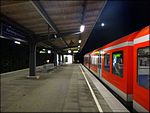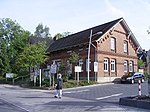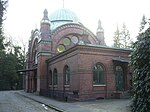Hamburg Commonwealth War Graves Commission Cemetery
Commonwealth War Graves Commission cemeteries in GermanyMilitary history of the United KingdomWorld War II cemeteries in GermanyWorld War II memorials in GermanyWorld War I cemeteries in Germany

Hamburg Commonwealth War Graves Commission Cemetery is a war cemetery which was built and is looked after by the Commonwealth War Graves Commission (CWGC). The war graves of 676 Commonwealth service personnel from World War I and 1,889 from World War II are located near Chapel 12 (German: Kapelle 12) in the greater Ohlsdorf Cemetery in the Ohlsdorf quarter of Hamburg.
Excerpt from the Wikipedia article Hamburg Commonwealth War Graves Commission Cemetery (License: CC BY-SA 3.0, Authors, Images).Hamburg Commonwealth War Graves Commission Cemetery
Lärchenallee, Hamburg Ohlsdorf (Hamburg-Nord)
Geographical coordinates (GPS) Address Nearby Places Show on map
Geographical coordinates (GPS)
| Latitude | Longitude |
|---|---|
| N 53.622222222222 ° | E 10.066944444444 ° |
Address
Lärchenallee
Lärchenallee
22337 Hamburg, Ohlsdorf (Hamburg-Nord)
Germany
Open on Google Maps









